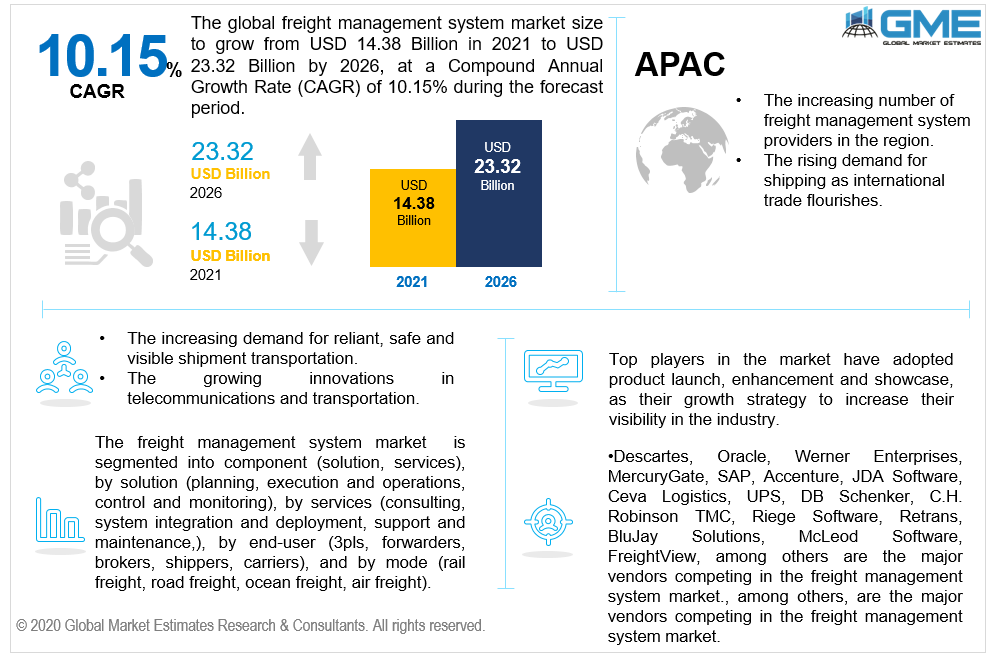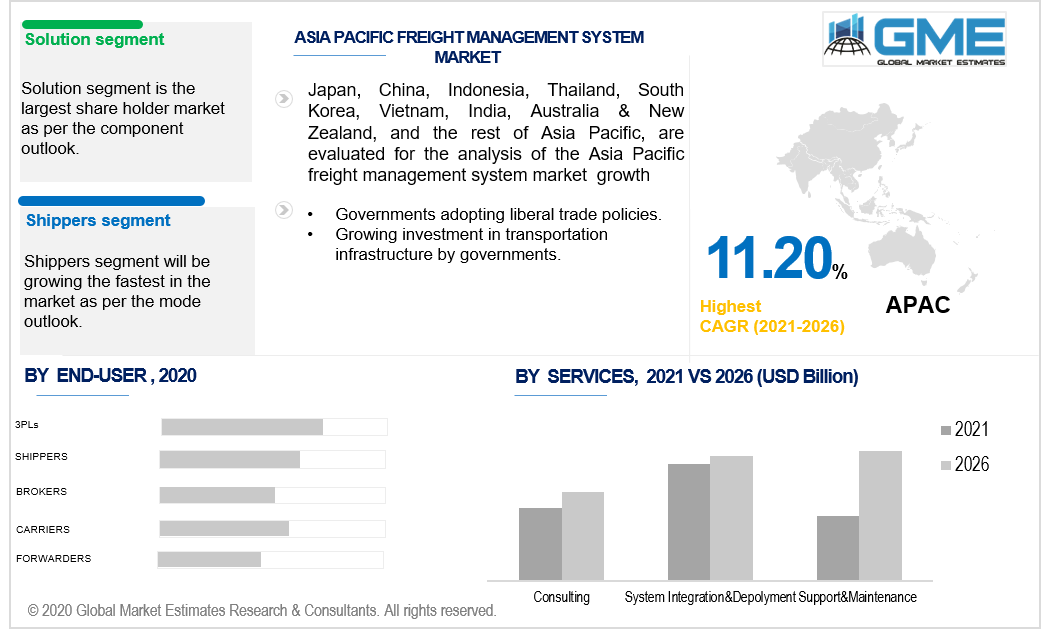
Global Freight Management System Market Size, Trends, and Analysis - Forecasts To 2026 By Component (Solution, Services), By Solution (Planning (Supplier and Vendor Management, Freight Order Management, Revenue Management, Dispatch Management, Claims Management,) Execution and Operations (Electronic Data Interchange, Load Optimization, Brokerage Operational Management, Freight Visibility, Freight Audit and Payment, Transportation Management System) Control and Monitoring (Freight Tracking and Monitoring Solution, Cargo Routing and Scheduling Solution, Cargo Security)), By Services (Consulting, System Integration and Deployment, Support and Maintenance,), By End-User (3PLs, Forwarders, Brokers, Shippers, Carriers), By Mode (Rail Freight, Road Freight, Ocean Freight, Air Freight), By Region (North America, Asia Pacific, CSA, Europe, and the Middle East and Africa); End-User Landscape, Company Market Share Analysis & Competitor Analysis
Freight management systems are used by supply chain and logistics professionals to ensure secure and on-time delivery of goods to their customers. These systems allow transportation companies to create a secure and efficient supply chain operation. The freight management system software helps customers to identify the best carrier rates, book orders, track shipments and negotiate with the carrier. As global communication systems and transportation technologies advance, there is a growing demand for greater shipping as international trades increase. The shipping companies need to ensure the security of their customers’ goods and ensure timely delivery of the shipments. The freight management system market is driven by the increase in international trade, adoption of novel technologies like IoT. The ability to track their shipments in real-time is becoming an important requirement among customers of shipping companies, the freight management systems allow for such tracking as well as security and control over their shipment while it is in transit. The growing number of free trade policies among governments has increased the imports and exports of countries and has hence driven the need for more freight management systems. The heavy initial costs are a cause of hindrance to smaller shipping companies that want to implement such systems. While many countries promote free or liberal trade among other countries some countries are not as receptive to importing foreign goods. Many shipping routes are congested due to poor infrastructure and hamper the growth of the global freight management system market.

As per component based segmentation, the market is segregated into solution and services. The solutions segment will occupy a major share in the market. The solutions segment of freight management system manufacturers includes all the options provided by services as well as support, knowledge and physical infrastructure from the vendor. Most companies that are implementing freight management systems do not have the technical know-how, infrastructure, and other vital aspects already in place, they have to rely on the freight management system vendor. The services section on the other hand is driven by companies that have an infrastructure in place and require an upgrade or specific solution to a problem they are facing.
Planning, execution & operations, and control & monitoring are considered under the solution segment. The planning sub-segment includes freight order management, dispatch management, claims management to name a few. While the execution and operations segment includes electronic data interchange, load optimization, freight visibility while control and operations include freight tracking and monitoring solutions. The control and monitoring segment has the highest share of the market as real-time tracking of shipments has become necessary for shipping companies.
Based on the services, the market is considered into consulting, support & maintenance, system integration & deployment. The system integration and deployment held the largest share of the market as more and more shipping companies are beginning to implement freight management systems. As companies are only recently beginning to implement freight management solutions, they require freight management systems to be integrated with their current setup and deploy a new model that enhances their existing transport system.
Based on the end-user, the market is considered and explained into 3PLs, brokers, forwarders, carriers, shippers among others. The 3PLs or third-party logistics segment held the largest market share while shippers were the fastest-growing segment. As companies find it cheaper to rely on third-party logistics for their distribution, shipping, and warehouse needs, third-party logistics providers are in demand and they need state-of-the-art freight management systems to ensure the satisfaction of their customers. Given the current global scenario, companies find it cheaper and more efficient to use third-party freight management companies than manage an in-house freight management system. The shippers' segment will propel at a high rate, due to the growing need for visibility of the shipments during transit. As shipping takes a longer duration than airways and given their riskier nature, consumers find it easier to trust companies that allow them to track and manage their shipments remotely while providing them with updates on their current location.
The road freight segment held the largest share of the market as it is the common form of transportation. Intra country transportation largely takes place through the road networks, the road freight management systems are in high demand as companies seek to track their shipment from the start as it can prevent malfeasances that occur during transit while also giving them the means to track the exact location of the shipment. Freight management systems are also capable of helping navigation and help reduce the transit duration.

The North American region is the most dominant market for freight management systems while APAC is the fastest-growing. The deeper penetration and implementation of the freight management system allow for the increased demand within this region. The APAC region is growing rapidly as governments’ begin to remove trade restrictions and work on their infrastructure. The growing number of solution providers within the APAC region will also play a vital role in the development of the freight management system market. As transportation improves, the cost associated with shipping will also fall resulting in more demand for faster and efficient shipping in this region.
Oracle (U.S), Werner Enterprises (U.S), MercuryGate (U.S), SAP (Germany), Accenture (Republic of Ireland), JDA Software (U.S), Ceva Logistics (Spain), UPS (U.S), DB Schenker (Germany), C.H. Robinson TMC (U.S), Riege Software (Germany), Retrans (U.S), BluJay Solutions (U.K), McLeod Software (U.S), FreightView (U.S), Freight Management (U.S), Linbis (U.S), Logisuite (U.S), DreamOrbit (India), Manhattan Associates (U.S), Descartes, Magaya Corporation (U.S), Kuebix (U.S), ImageSoft (Australia), and 3GTMS (U.S) among others, are the major vendors in the market.
Please note: This is not an exhaustive list of companies profiled in the report.
We value your investment and offer free customization with every report to fulfil your exact research needs.
The Global Freight Management System Market has been studied from the year 2019 till 2026. However, the CAGR provided in the report is from the year 2021 to 2026. The research methodology involved three stages: Desk research, Primary research, and Analysis & Output from the entire research process.

The desk research involved a robust background study which meant referring to paid and unpaid databases to understand the market dynamics; mapping contracts from press releases; identifying the key players in the market, studying their product portfolio, competition level, annual reports/SEC filings & investor presentations; and learning the demand and supply-side analysis for the Freight Management System Market.

The primary research activity included telephonic conversations with more than 50 tier 1 industry consultants, distributors, and end-use product manufacturers.

Finally, based on the above thorough research process, an in-depth analysis was carried out considering the following aspects: market attractiveness, current & future market trends, market share analysis, SWOT analysis of the company and customer analytics.

Tailor made solutions just for you
80% of our clients seek made-to-order reports. How do you want us to tailor yours?
OUR CLIENTS